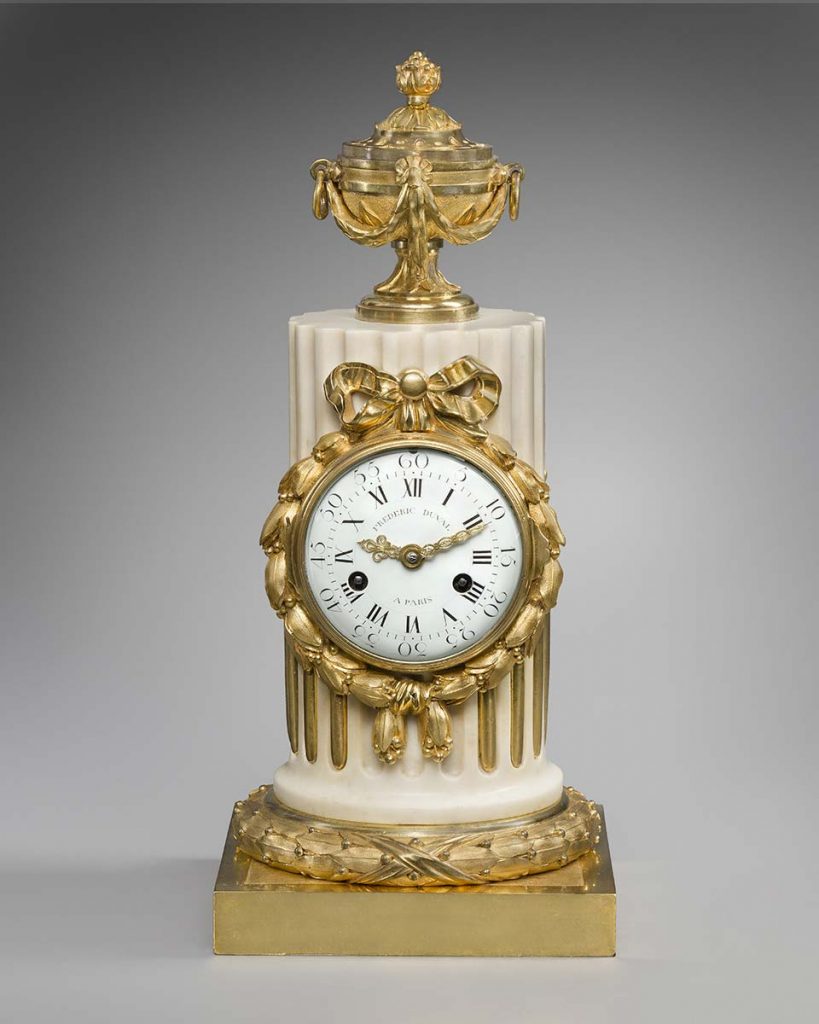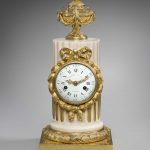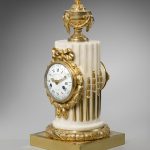A marble and bronze pedestal clock by Osmond

Pendule ancienne
A late Louis XV gilt bronze and white marble mantel clock,
the dial and movement signed FREDERIC DUVAL A PARIS,
the case attributed to Robert and Jean-Baptiste Osmond – circa 1770-1775
Robert Osmond (1711-1789), maître in 1746
Jean-Baptiste Osmond (1742- after 1790), maître in 1764
Frédéric Duval (d. after 1783)
Height: 35 cm. (13 ¾ in.) Width: 16 cm. (6 ¼ in.) Depth: 15.7 cm. (6 ¼ in.)
Enamelled dial bearing the signature, with Roman numerals indicating the hours and Arabic numerals for the minutes with pierced and engraved gilt brass hands. The circular movement bears the signature and has a recoil lever escapement and silk-thread suspension and strikes the hours and half-hours by means of a count wheel mounted on the back-plate.
Provenance
Richard Redding, Switzerland
Comparative Literature
H.Ottomeyer and P. Pröschel, Vergoldete Bronzen, vol. I, Munich, 1986, p. 194, fig. 3.12.3.
J.-D. Augarde, Les Ouvriers du Temps, Geneva, 1996, p. 311.
P.Kjellberg, Encyclopédie de la pendule Française, Paris, 1997, p. 185.
P.Hughes, ‘French Fashion at Petworth’, Apollo, September 2008, p. 63, pl. 5.
G.Wannenes, Les plus belles pendules françaises, Florence, 2013, p. 271.
The bronzier, Robert Osmond (1711-1789) was a pioneer of the Neoclassical style in 1760s Paris. He worked with his nephew, Jean-Baptiste, and the Osmonds produced pedestal clocks in two versions: one, like this, with a neo-grèc vase to the top, and the other with billing doves.
The former model corresponds to a design preserved in the Bibliothèque Doucet, Paris (no. 54) and priced at 198 livres.
Several examples of clocks of this design but entirely in gilt bronze are known:
- In the Royal Palace, Stockholm, illustrated in Ottomeyer and Pröschel, cit., fig. 3.12.3 (signed Gudin à Paris)
- At Petworth House in West Sussex (inv. NT 485686) illustrated in Hughes, cit., pl. 5 (the dial and movement signed Duval)
- One formerly in my gallery, illustrated in Kjellberg, cit., p. 185 (signed Louis Montjoye)
- Another formerly in my gallery, illustrated in Wannenes, cit., p. 271 (signed Louis Montjoye)
This however, is the only known version that combines gilt bronze and marble.
Frédéric Duval
Frédéric Duval (d. before 1783) was a journeyman for François Beliard and then worked alone before becoming a member of the Parisian clockmaker’s guild in 1777. His workshop is recorded on rue Mazarine (in 1778) and then rue Jacob (1781).
He used clock cases by Jean-Joseph de Saint-Germain, Bonnet, Poisson, Morlay, Duhamel and Osmond. Duval supplied many clocks to the Duc de Choiseul (see Augarde, op. cit., p. 311).


